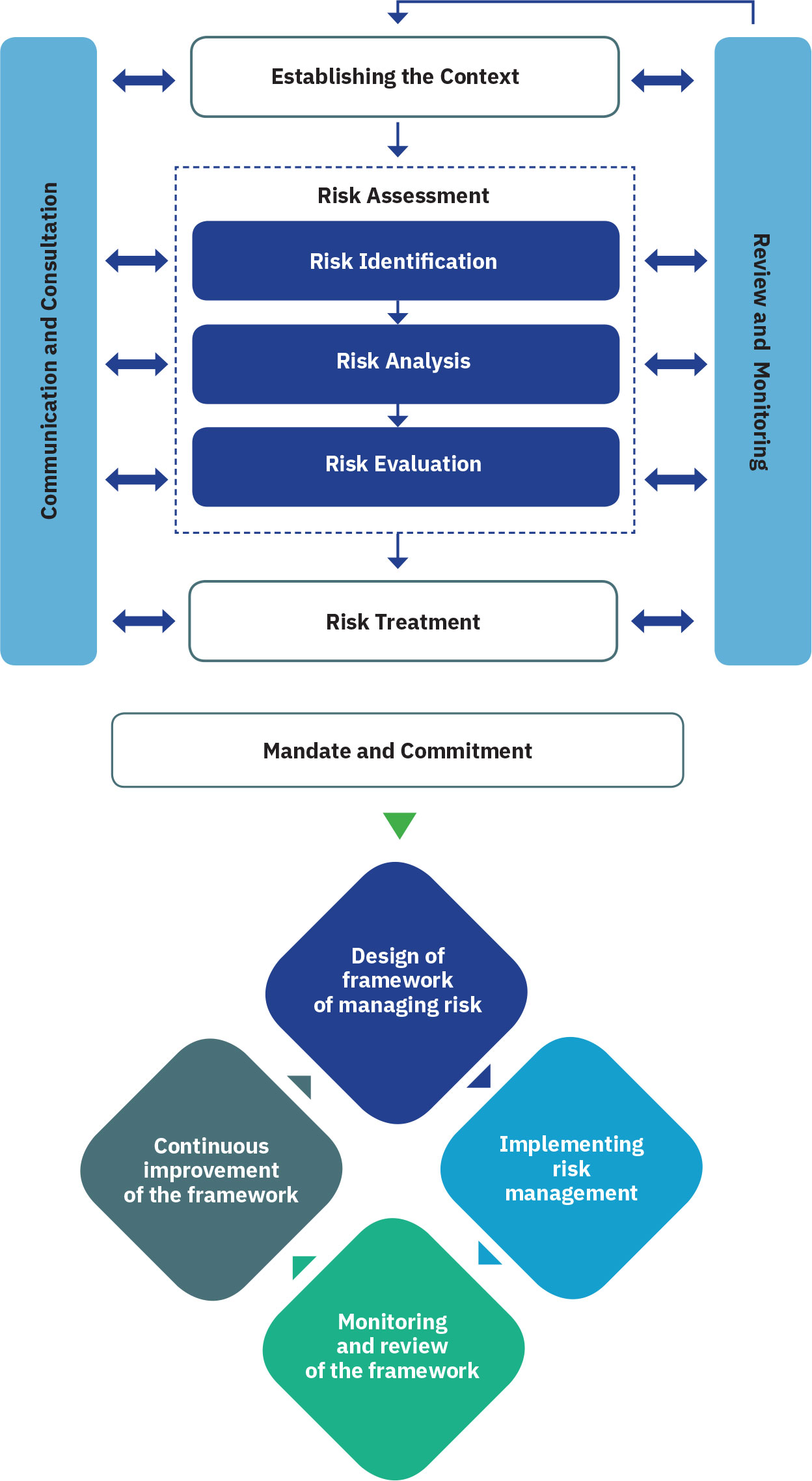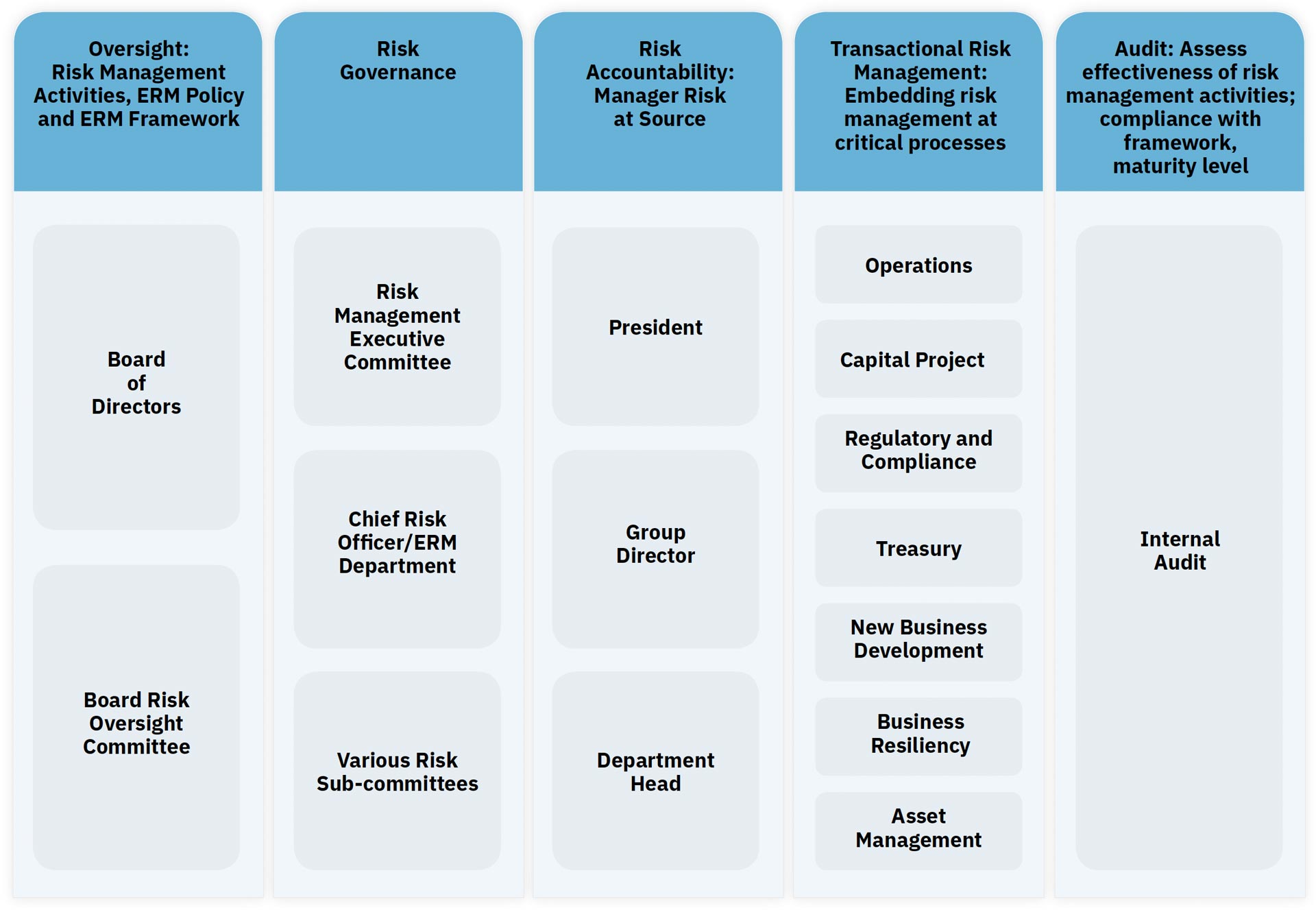Strategy, Sustainability and Risk
As Manila Water faces greater challenges in the Manila Concession, effective risk management becomes more critical to ensure that the company will be able to fulfill its goals as a leader in the provision of water, wastewater, and environmental services in the country.
Risk management is consistently used as a tool for effective decision-making, planning and operations, resulting to a resilient and agile organization amidst difficulties in its regulatory and physical environment.
ENTERPRISE RISK MANAGEMENT IN MANILA WATER
Manila Water operates in a regulated and dynamic business environment where uncertainties, both detrimental and opportune to the Company, abound. The Company is accountable to its regulators, shareholders, employees and customers, among others. Profitability, sustainable development and corporate social responsibility are expected to be continuously enhanced. In order to achieve its corporate objectives, Manila Water recognized the need for the active management of risks inherent to its business which involves the entire organization.
Manila Water continues to implement its Enterprise Risk Management (ERM) Program based on a globally accepted approach, the ISO 31000:2009. The ERM Program has been cascaded to Manila Water Enterprise which includes subsidiaries and affiliates in Manila Water Philippine Ventures, Inc. (MWPV) and Manila Water Asia Pacific Pte. Ltd (MWAP) to ensure attainment of its objectives.
ERM Strategy Statement
ERM shall aim to integrate risk awareness and responsibility into each level of management activities, and into all strategic planning and decision-making processes within the company.

The ERM Program operationalizes the Company’s Manual of Corporate Governance which mandates the Board of Directors (BOD) to ensure the presence of organizational and procedural controls supported by an effective management information system and risk management reporting system. In addition, the Company’s Board Risk Oversight Committee (BROC) provides oversight to management functions relating to strategic, financial, operational, compliance, legal, environmental, social and other risks of the Company. This involves periodic disclosure of significant risk exposures and related risk management activities.
The President is the comprehensive risk executive and is ultimately responsible for ERM priorities, strategies, tolerances and policies. He chairs the Risk Management Executive Committee (RMEC) which is composed of top management and the Chief Risk Officer (CRO). The RMEC provides oversight and input to the President and to the Board to enable them to formulate better and informed decisions on matters related to risks. The RMEC provides direction on the design and implementation of appropriate systems, tools and methodologies to support the ERM process and other risk management activities and designates owners of specific risks and enablers of the ERM process (ERM Champions/ Partners/Risk Officers).
The CRO is the ultimate champion of ERM at Manila Water. Supporting the CRO is the Enterprise Risk Management (ERM) Department. It is responsible for developing risk management tools, methodologies and processes. It also leads the implementation and dissemination of ERM across the Manila Water group in coordination with the risk owners, the CRO and ERM Champions/Risk Owners of the business units. With the ERM mindset continuously being assimilated into the Company’s culture and practices, ERM has been embedded in the strategic, tactical and execution planning as well as in key-decision making processes including insurance management. Manila Water has a risk-based insurance program wherein coverage considers relevant risks and existing controls in place. The integration of ERM with insurance management ensures that insurance provisions in contracts are custom-fit to respond to specific project risks.
The risk management system of Manila Water is reviewed and assessed annually by the Internal Audit Department using a risk maturity assessment framework aligned with global best practices to determine the system’s adequacy, suitability and effectiveness. Manila Water is subjected to external assessment every three (3) years. The last external assessment of Manila Water Company’s ERM maturity was conducted by Ayala Corporation through Aon Philippines in 2018.
ERM STRUCTURE

2019 ERM HIGHLIGHTS
The following activities were carried out to improve the Risk Management System of Manila Water Enterprise:
Maintenance of Quality Management System for Insurance Management.
As an affirmation of adherence to global best practices, ERM Department’s Insurance Management Section successfully passed its ISO 9001:2015 surveillance audit.
Insurance Renewal and Optimization.
ERM Department was able to enhance the insurance coverage of various lines which resulted in savings.
MANAGEMENT OF TOP ENTERPRISE RISKS
The Risk Management Executive Committee (RMEC), composed of Manila Water Company’s Management Committee and the Chief Risk Officer (CRO), which determines the most significant risks facing the Company. Management of Top Corporate Risks, which have been mapped up to the department level, and was delegated to the appropriate Risk Owners.
For Manila Water Philippine Ventures and Manila Water Asia Pacific, the RMEC is composed of the President/Chief Operating Officer, Leadership Team and the CFO/CRO.
Risk Owners formulate and commit to a risk management plan, monitored by the ERM Department, which defines specific action points, accountability and timeline. The status of the Top Enterprise Risks is regularly discussed at the RMEC and is reported to the Board Risk Oversight Committee.
| 2019 TOP ENTERPRISE RISKS | MITIGATION STRATEGIES |
|---|---|
|
POLITICAL AND REGULATORY Failure to manage political and regulatory stakeholders which can lead to revision or termination of the Concession Agreement. |
Manila Water proactively participated and advocated with the MWSS for the passage of Concession Accounting and Auditing Guidelines (CAAGs) and Technical Audit Guidelines (TAGs). A more stringent monitoring was done on the delivery of service obligations among groups internally to ensure compliance and prevent issues. Kept open lines of communications and engaged with various stakeholders to provide clarifications on compliance to service obligations, strengthen relationship, and advocate for matters relating to the validity and protection of the Concession Agreement & its financial viability. Proactively prepared and participated in legislative proceedings and various fora and conferences of industry organizations to stand for the truth on the operational efficiency & performance of Manila Water and avert its being muddled with fake news and false information. |
|
LEGAL RISK Failure to secure a favorable Supreme Court resolution regarding the Clean Water Act issue which can lead to termination of the Concession Agreement. |
Filed the Motion for Reconsideration (MR) for the unfavorable Supreme Court Decision imposing penalties. Coordinated and aligned with MWSS and Maynilad on arguments and issues to raise prior to the filing of the MR. Strong and responsive information/clarification and communication initiative (social media) with due consideration to the sub judice rule (which means that when a matter is before the court, it should not be discussed in other fora) |
|
WATER SUPPLY
|
All existing sources are maximized including Cardona Treatment Plant. Continuous effort to secure the 40% allocation at the portal. Building additional capacity from immediate new term water sources. For 2019, Manila Water built additional capacity at of over 100 MLD. Extensive pressure management and network reconfiguration practiced to equitably distribute limited supply of water. |
|
CAPEX EXECUTION Failure to execute Capex plan per Approved Business Plan on a timely manner and cost basis leading to MWSS Regulatory Office (RO) tariff claw back and non-recoverability of expenses. |
Initiated and implemented Project Ark. Project Ark is a cross-functional and comprehensive program aimed at identifying gaps and implementing critical changes targeted to improve CAPEX delivery. The program targeted core CAPEX processes, policies, tools, and structures critical to being able to fast-track our water supply and wastewater commitments and meet the 2019-2022 CAPEX target of P86 billion. Ark 1.0 (Phase 1) includes improvement in the CAPEX organizational structure and delivery strategy by (a) creating a more aligned and streamlined project team structure within Corporate Project Management Group (CPMG), (b) maximizing technical talents in the organization by decentralizing project execution, (c) establishing the Strategic Procurement and Supply Chain Group to allow for a more flexible and targeted approach to procurement, (d) implementing a more structured and holistic approach to land acquisition, and (e) applying a more efficient revised approval process. Ark 2.0 (Phase 2) specifically targets process improvements, aimed at further improving end to end CAPEX delivery by reducing touch points and cycle times across all critical processes. This sub-program aims to improve CAPEX throughput by utilizing workflows, automation, reports, and dashboards to improve visibility and streamline coordination across all units. Ark 2.0 is currently ongoing and is expected to be completed by June 2020. Continued to embed more effective risk identification and management in all processes, standardizing to the appropriate measure to deliver projects aligned with targeted timeliness, cost, safety and quality, and documented effectively to align with the CPMG Quality Management System and MWSS RO guidelines. |
|
FINANCIAL RISKS Liquidity Risk
Loan Default Risk
|
Various initiatives have been implemented to ensure that the company is able to mitigate liquidity risk. Reduction in OPEX and streamlining of CAPEX are some of the cash conservation strategies that the company undertook. Focus was likewise given to tighter and more efficient liquidity planning and monitoring which includes better disbursement oversight and raising new sources of funds. Proactively managed relationship with its lenders by ensuring that they are updated on the various corporate developments in Manila Water. The company held several lenders’ briefings where Manila Water’s management discussed and clarified various news reports and updated partner banks on the status of its operations and other legal matters (e.g. review of the Concession Agreement). Timely payment of debt maturities and submission of loan compliance requirements are also strictly observed to ensure compliance with loan provisions/covenants. |
|
BUSINESS CONTINUITY Operational Risk |
Continuous improvement of MWC Business Continuity Management, which is composed of risk reduction and management, incident management, business continuity planning. Completed resiliency and business interruption study and implemented projects covering earthquake, typhoon, flooding and fire. This includes retrofitting facilities and activating emergency online reservoirs and deepwells. Improve monitoring and alert systems through the strengthening of the Operations Monitoring and Control Center. For incident management, acquired contingency vehicles and 40 business continuity responders. |
|
COMPLIANCE RISKS Regulations Compliance
Rate Rebasing Commitments Compliance
|
For existing water sources, adherence to Water Safety Plan is practiced. For Deepwell (as new water source), its operations and maintenance is further established and is augmented by partner service providers To address root cause of the risk which is the lack of control over the quality of the influent received at the plants, MWC:
Timely submission of reports and responses to letters of inquiries from MWSS (RO, CO and Board of Trustees) Strict implementation of Asset Management Plan for asset renewal or asset improvement to avoid non-conformance in operating results particularly in Wastewater Facilities. Stringent review of the Key Performance Indicator and Business Efficiency Metrics. Internally assessed the alignment of CAPEX accomplishment using the Technical Audit Guidelines and the components of Opening Cash Position using Concession Accounting and Auditing Guidelines. |
|
BRAND AND REPUTATION Failure to maintain Manila Water’s stature as a company which may result in significant difficulty in creating and/or maximizing value for all stakeholders and may affect the ability to execute growth plans, affect employee morale and the ability to attract talents. |
Brand-building initiatives are in place to strengthen internal and external stakeholder engagement. A steady stream of positive news in traditional and non-traditional media channels are published regularly to highlight company accomplishments, alongside goodwill programs and partnerships with TV, radio and print media. Equal attention is also given to maximizing online presence through social media channels and website. Programs promoting Information, Education and Communication (IEC) of the company’s advocacies as well as collaboration with key stakeholders on agreed areas of synergy are also implemented. |
|
TALENT MANAGEMENT Talent Capacity
Team and Organizational Connection
|
A robust succession plan is in place to ensure a strong pipeline for critical roles. The Technical Development Curriculum has been developed in partnership with the Operations Subject Matter Experts to ensure that the Company further strengthens and sustains the technical capabilities within the organization. This is complemented by the Core and Leadership Development Programs offered to talents to foster a values-based and institutionalized ways of working across all levels and roles. |
|
NEW BUSINESS OPERATIONS Failure to operate new businesses properly as a result of poor integration, planning and execution. |
The Subsidiary Operations Group (SOG) was created to oversee all operating subsidiaries. It is headed by a Group Director who directly supervises the General Managers of the subsidiaries to enforce functional standards across the business units. Under SOG supervision, transition teams are created to properly implement integration activities as new businesses transition from development phase to operating stage. |
|
NEW BUSINESS DEVELOPMENT Failure to launch significant new businesses to meet current and future business objectives. |
Regional Business Development with different leadership teams are in place to handle business development and look for business expansion opportunities in their respective areas. Manila Water’s review framework of new business projects includes risk assessment and is a critical component in the business development and approval process. The risk profile of the project is considered in the determination of the cost of capital. |
For the year ended December 31, 2019
The Board Risk Oversight Committee (“Risk Committee”) was established by the Board of Directors at its August 11, 2015 meeting to provide assistance in fulfilling the Board’s oversight responsibilities in relation to risk governance in Manila Water. The Risk Committee’s roles, responsibilities and authorities are defined in the Risk Committee Charter approved by the Board of Directors during its November 26, 2015 meeting.
In compliance with the Risk Committee Charter, the Committee confirms that:
| Directors | No. of Meetings Attended/Held | Percent Present |
|---|---|---|
|
Jaime C. Laya |
2/2 |
100% |
|
Jose L. Cuisia, Jr. |
2/2 |
100% |
|
Oscar S. Reyes |
2/2 |
100% |
|
Gerardo C. Ablaza, Jr. |
2/2 |
100% |
March 16, 2020

JAIME C. LAYA
Chairman

GERARDO C. ABLAZA, JR.
Member

JOSE L. CUISIA JR.
Member

OSCAR S. REYES
Member